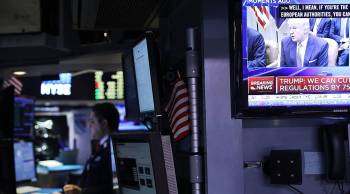High-speed trading goes off the Street
TEXT OF STORY
Kai Ryssdal: It usually takes a while for Congress to catch on to exactly what Wall Street’s doing. A couple of months ago the big story was high-frequency trading. How super speedy computers and complicated software could be skewing the market in favor of just a handful of firms.
Well, this week the Senate asked the SEC to take a look at the practice. One estimate by the research firm Tabb Group says almost three-quarters of all Wall Street trades are done by high-speed computers. Jill Barshay explains the action doesn’t really happen on Wall Street at all.
JILL BARSHAY: When Vasant Dhar was running a hedge fund, he worked out what a lot of big banks and top flight money managers are realizing these days: You don’t have to take big risks to make a lot of money. Instead, you just need speed.
VASANT Dhar: If you can have that edge, where you can get in your order a millisecond faster than someone else, then you’re there before someone else was.
And being there first means making a fraction of a penny. Do that a few million times and you’re talking real money. High-frequency trading is all about volume. The more trades you execute, the more money you make.
Dhar: So it’s like a cash machine with very little risk. That’s what’s really appealing about it. You just make money every day.
The high-frequency trader’s building blocks are a lightning-fast computer and software that can buy shares by the bushel in the blink of an eye. There’s one more key component: location.
If you’re in Greenwich, Conn., and you place an order to buy a stock, it could take a half-a-thousandth of a second for the order to reach an exchange. But if your computer is sitting in the same building with the exchanges’ matching engines, the computers that put buyers and sellers together, your order gets to the exchange 50 times faster.
Today Vasant Dhar teaches trading strategies at New York University’s Stern School of Business. But back when he was a high-frequency trader, he placed his computer at a co-location facility.
This is the Equinix’s co-location facility. It’s a squat cement warehouse the size of five football fields. And it’s not on Wall Street. It’s four miles west of Manhattan in Secaucus, N.J.
MATT Melis: So if you look down the row here, you can see it’s just cages upon cages upon cages.
Matt Melis is an engineer at Equinix. He oversees the rows of darkened cages, each of which holds dozens of computers and servers.
Melis: Imagine your PC that sits under your desk or in your home. And then imagine a big giant warehouse with 3 million of those. And that’s kind of what you’re looking at in a facility like this.
The computers belong to investment banks, brokerages, hedge funds. Some of them lease space from a company called Gravitas, which rents a cage in the facility and then sublets it. CEO Jayesh Punater has 40 clients. They like the high security and the climate control. But the biggest draw is the neighbors, which include some of the biggest stock exchanges in the country.
JAYESH Punater: The New York Stock Exchange is also here. Or some of the exchanges are also here, like — we can’t name them actually, but some of the exchanges also have terminated their servers here at this facility. So it gives a lot of the other private exchanges and clients equal access to them as if they were in downtown, on Wall Street in the exchange, in the exchange space.
The New York area is dotted with these vast post-modern trading pits. They give even relatively small investors the same access as the big, wealthy players have.
Punater: You don’t need to come here to do it. You can sit in your office in Midtown Manhattan or be in Greenwich and log into these computers and do all the work.
Punater charges a few thousand dollars a month for his services. Combine that with off-the-shelf trading programs and computers, and nearly anyone can juice their trading velocity.
The possibility of making fast money — really fast money — is attracting more and more players to co-location facilities.
Equinix doubled the size of its data center this summer. It plans to grow by another 50 percent next year.
Even in these days of being connected wherever you are, it’s still all about location, location, co-location.
In New York, I’m Jill Barshay for Marketplace.
There’s a lot happening in the world. Through it all, Marketplace is here for you.
You rely on Marketplace to break down the world’s events and tell you how it affects you in a fact-based, approachable way. We rely on your financial support to keep making that possible.
Your donation today powers the independent journalism that you rely on. For just $5/month, you can help sustain Marketplace so we can keep reporting on the things that matter to you.


















